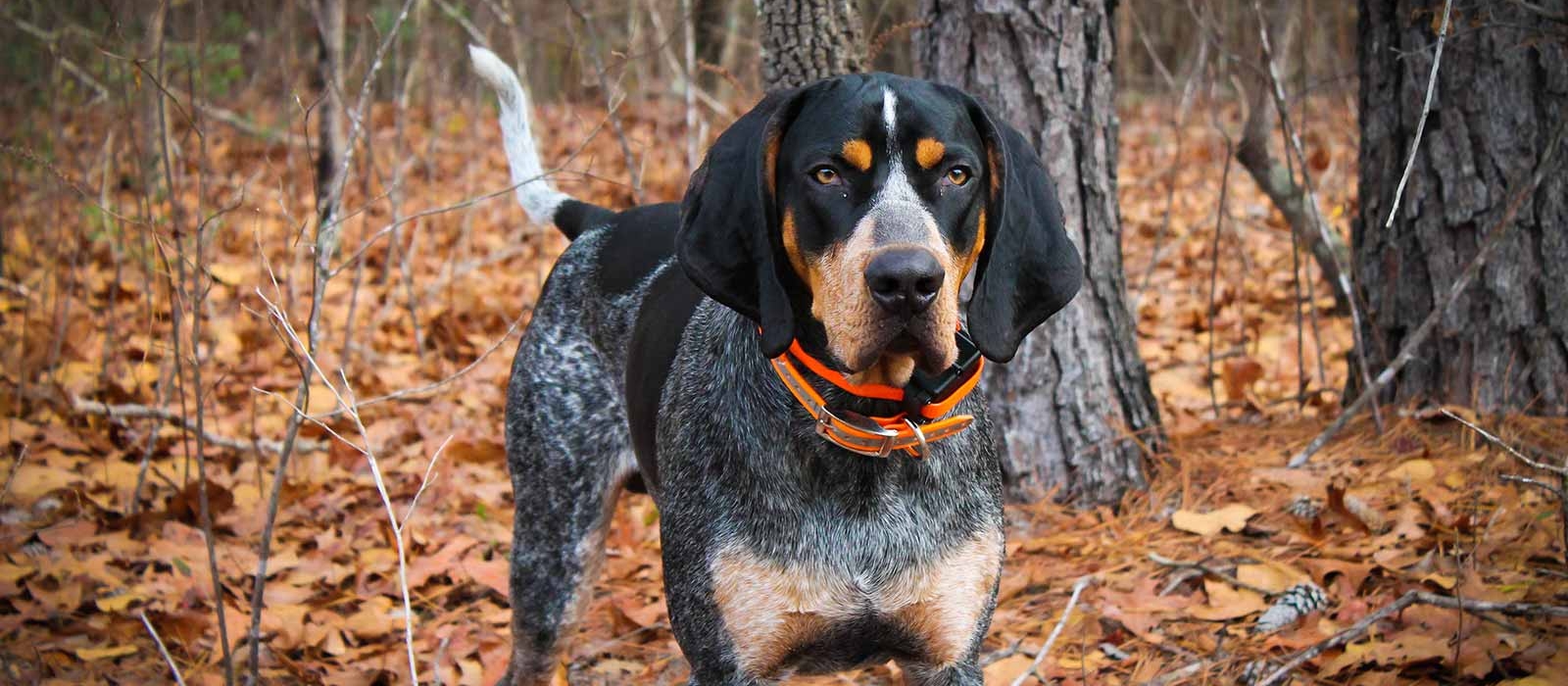-
Activity Level:
high
-
Shedding Level:
moderate
-
Grooming Level:
low
-
Trainability:
moderate
-
Good for Novice Owners:
moderate
-
Adaptability:
moderate
-
Kid/Pet Friendly:
often
-
Prey Drive:
high
-
Watchdog:
very alert
- Average Size: Medium
- Average Lifespan: 11-12 years
- Registered?: aca, akc
Bluetick Coonhound Dog Breed Information
Overview
Temperament
Adaptability
Health
Owner Experience
Grooming
Activity Level
Size
Life Span
Did You Know?
One of the facts about Bluetick Coonhounds is that they are an original American dog breed. The Bluetick Coonhound originated in the United States and dates back to before the country’s founding. The “ticked” or mottled black-and-blue pattern of their coat and their main function gives them their name. They are a scenthound that was developed specifically for tracking down nocturnal prey like raccoons.
It is thought that the Bluetick Coonhound was created by mixing George Washington’s French staghounds gifted by the Marquis de Lafayette with the English Foxhound and other hound breeds. The goal was to create a scenthound that could pick up a scent that was days or even a week old with the endurance to track it as long as necessary.
Early frontiersmen mainly used the Bluetick Coonhound to pursue raccoons. But, they also often worked in packs to track down bigger game like cougars, lynxes, wild boars, and bears. Although they are an older American breed, the American Kennel Club didn’t recognize the Bluetick Coonhound until 2009. They are a member of the Hound Group.
A Bluetick Coonhound is a beautiful dog with a charming personality. They have a sweet disposition, are affectionate, and are devoted to their families. These hound dogs crave affection and are loyal to their families. They’re also considered one of the kid-friendly dog breeds. Although they tend to get along well with children and other dogs when they are well-socialized, they may not be the best fit for homes with other smaller pets due to their high prey drive.
It’s important to manage prey drive in dogs and channel it into some sort of activity, so it doesn’t result in undesirable behaviors. Bluetick Coonhounds are also vocal dogs. Similar to Beagles, they tend to have three main vocalizations bawling, baying, and barking. Their bark is usually short and choppy while bays are deeper, louder, and longer barks and bawls are more like howls.
The Bluetick Coonhound is a low to moderately adaptable dog breed. They tend not to be a good fit for apartment living and are much better suited to larger homes with fenced-in yards where they can run.
Because of their high prey drive and strict focus when they are on a scent, they should only be let off-leash in securely fenced areas. These dogs are true hound dogs, so the exception to this is if you have trained your Bluetick Coonhound to hunt with you and have equipped them with a tracker before letting them loose in the woods.
They do well in most climates. As with any dog breed, they are sensitive to extreme heat and cold. They also do not like to be left alone for long periods of time because they are so loyal and devoted to their families. Plus, they love attention and thrive on affection from their favorite humans.
The Bluetick Coonhound is a generally healthy dog breed. Reputable breeders will be screening their dogs to ensure they are not passing preventable issues to puppies. Make sure you ask about the health and genetic history of both parents.
You can also ask about any health tests or clearances that have been done. The National Bluetick Coonhound Association doesn’t currently list specific test recommendations for minimum requirements. However, their code of ethics does emphasize the use of available health/DNA testing when needed and where applicable to ensure the health of the breed and individual dogs is maintained.
As a deep-chested dog, Bluetick Coonhounds are at a higher risk for bloat. Bloat in dogs can quickly become a life-threatening condition if gastric torsion occurs (i.e.; if the stomach flips). It’s important to know how to reduce the risk as well as the early signs and symptoms so you can get to the vet immediately. Also, because they have low-hanging ears, they are more prone to developing ear infections, which makes regular ear checks and care even more important.
The Bluetick Coonhound is a moderately trainable dog breed. Although they are intelligent and eager to please, their high-energy, high prey drive, and hardworking nature can be an obstacle for first-time or novice dog owners to handle. Puppy training and obedience classes, especially if there is a trainer with hunting dog experience, can be a big help.
These classes also often offer opportunities to socialize a puppy. Because the Bluetick Coonhound is a vocal dog, it’s also important to work on “voice-training” them early on. You won’t be able to stop their barking or howling completely as some of it is instinctual, but you can work to train your dog to stop barking in response to a command or cue to keep it from becoming a nuisance behavior.
The Bluetick Coonhound is known for their short, glossy, and mottled coat. They shed moderately year-round and only require weekly brushing and the occasional bath as needed. A grooming mitt or hound glove and a medium-bristle brush are good dog grooming brushes to have on hand.
In addition to coat care, you will also need to take care of your Bluetick Coonhound’s nails, ears, and teeth. Once or twice monthly nail trimming is usually sufficient to keep nails from growing too long. If they grow quickly or just aren’t wearing down as much naturally, you may need to cut your dog’s nails more often. Weekly ear checks and carefully cleaning your dog’s ears as needed can help prevent ear infections.
On top of that, it’s important to practice good dental care for dogs. Gum disease is one of the most common health issues in dogs because of poor or no dental care throughout their lives. You can help prevent painful dental diseases like gum disease, tooth decay, and tooth loss later in life by brushing your dog’s teeth or using an enzyme toothpaste every day, in addition to cleanings at the vet when needed.
This is a high-energy dog breed. They may enjoy a nap every now and then, but they are hunting dogs that need a job to do and still need plenty of exercise to be happy and healthy. Daily walks plus some time to run and some extra activity are usually enough for a Bluetick Coonhound.
But, when it comes to dog sports like agility, obedience, tracking, and hunting and field trials, they’re likely to find more energy for it. Plus, training for dog sports gives them a job to do and can give them a positive outlet for their high prey drive.
A fully-grown Bluetick Coonhound usually stands 21-27 inches tall and weighs 45-80 pounds. Although individual dogs can vary, females tend to average 21-25 inches tall and 45-65 pounds while males tend to average 22-27 inches tall and 55-80 pounds.
Bluetick Coonhounds generally live for 11-12 years on average.
The Bluetick Coonhound has been the University of Tennessee’s mascot since 1953.






